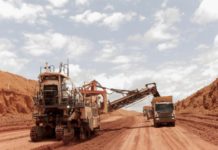
[miningmx.com] — A deluge of money into industrial metals betting on stronger economic growth and demand has produced a spectacular rally that is sustainable, but probably only for a short while.
That is why investors with a time horizon of more than a few months need to watch inventories and keep tabs on consumer and corporate confidence and demand, which could disappoint.
Industrial metals have been volatile in recent weeks, but the general trend has been for higher prices.
Prices of copper used in power and construction, and aluminium used in transport and packaging are up about 50 percent at $6,000 and $1,980 a tonne respectively since April when markets started to see signs of economic stabilisation.
“The upward price momentum in commodity markets is strong. They are only looking at positive data now, just as in the last quarter of 2008 and the first quarter of 2009 they only looked at negative data,” said Eugen Weinberg, analyst at Commerzbank.
Reasons for the flood of money into industrial metals also include perceptions that the worst of the recession is over and restocking by corporates after an intense period of running down inventories.
The weaker U.S. currency too played a major role for many investors, who naturally associate a lower dollar with cheaper commodity prices.
“There’s a lot of cash on the side that’s been happy to move into commodities,” said Joel Crane, analyst at Deutsche Bank.
“We are sensing signs of a major disconnect between fundamentals and price momentum. Metals inventories are rising, particularly aluminium, zinc, copper.”
PUMPING MONEY
China is the world’s largest consumer of industrial metals. Its fiscal stimulus packages of nearly $600 billion announced last November has helped boost optimism and expectations for industrial metals demand growth.
The package is one reason why China has been replenishing its stocks of industrial commodities.
“The magnitude of this buying took many by surprise as China became a net importer of base metals,” said Catherine Virga, analyst at CPM Group.
“Chinese influence on the market has extended well into the third quarter and we now expect consumers outside China to step in as buyers to restock their own depleted stocks.”
Stimulus packages in other countries, historically low interest rates and central banks pumping money into the system have all helped to stave off a 1930s style depression.
“The macro economic backdrop is incrementally supportive for base metals,” said Michael Jansen, analyst at JPMorgan. “The second-half pullback argument doesn’t make any sense.”
INCOME EROSION
Looking ahead into next year, many expect rising unemployment to hamper individual and corporate demand and hit tax revenues, already under the cosh from the slowdown.
Throw into the mix a period of government cutbacks, potentially higher tax rates and interest rates — to ward off inflation — and the omens are not good.
This is why some metals consumers do not expect to see a real demand picking up until possibly the second half of 2010.
Among them are Finnish copper fabricator Luvata, which in July said it does not expect a significant demand increase for copper until the middle of 2010.
An executive at a U.S. firm also told Reuters earlier this week that his company would not be buying any aluminium until next June “when prices will be lower”.
This is partly because consumers know about the financing deals — which are said to have tied up about 70 percent of the record 4.56 million tonnes of stocks in London Metal Exchange warehouses until May 2010.
Aluminium prices are expected to tumble as these deals mature and more than 320,000 tonnes — about 9 percent of global annual aluminium consumption — hits the market.
Copper stocks have risen to above 292,000 tonnes in LME warehouses, after nearly halving to about 250,000 tonnes in July from levels around 500,000 tonnes in April. Much of the draw is said to have found a home in China.
“Higher commodity prices, unless validated, by higher pay awards, act to dampen activity by eroding real incomes. This then feeds back into lower demand for commodities,” Lombard Street Research said in a note.
“Add to this that much of the recent rise in commodity prices seems to be due to a build-up of Chinese inventories and the prospect is rather one for lower commodity prices.”










